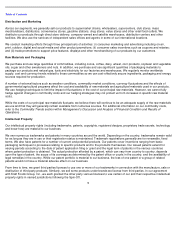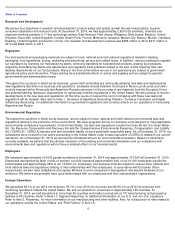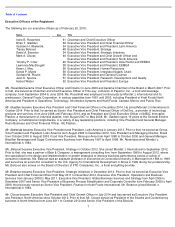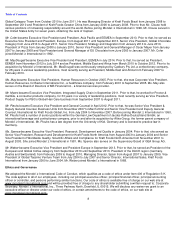Mondelez 2014 Annual Report Download - page 18
Download and view the complete annual report
Please find page 18 of the 2014 Mondelez annual report below. You can navigate through the pages in the report by either clicking on the pages listed below, or by using the keyword search tool below to find specific information within the annual report.
Table of Contents
In connection with management’s assessment of internal control over financial reporting under Section 404 of the Sarbanes-Oxley
Act of 2002 for the fiscal year ended December 31, 2013, we determined that we did not maintain effective monitoring and
oversight of controls over the completeness, accuracy and presentation of our accounting for income taxes, including the income
tax provision and related tax assets and liabilities. We determined that the ineffective monitoring and oversight of controls over
income tax accounting constituted a material weakness. As of December 31, 2014, we made substantial progress toward
remediating the material weakness. See Item 9A, Controls and Procedures , for a discussion of the material weakness and the
progress on the remediation. If the new controls we have implemented to address the material weakness and to strengthen our
overall internal control over accounting for income taxes are not designed or do not operate effectively, if we are unsuccessful in
implementing or following these new processes or if we are otherwise unable to remediate this material weakness, we may not
timely or accurately report our financial condition or results of operations. This could adversely affect our stock price and the
confidence of investors, business partners and others in our financial reports.
We are increasingly dependent on information technology.
We rely on information technology networks and systems, including the Internet, to process, transmit and store electronic and
financial information, to manage a variety of business processes and activities, and to comply with regulatory, legal and tax
requirements. We also depend on our information technology infrastructure for digital marketing activities and for electronic
communications among our personnel, customers and suppliers around the world. These information technology systems, many of
which are managed by third parties or used in connection with shared service centers, may be susceptible to damage, disruptions
or shutdowns due to failures during the process of upgrading or replacing software, databases or components thereof, power
outages, hardware failures, computer viruses, attacks by computer hackers or other cybersecurity risks, telecommunication failures,
user errors, natural disasters, terrorist attacks or other catastrophic events. Furthermore, to the extent our information technology
systems are managed by third parties or used in connection with external shared service centers, we would have to coordinate with
these third parties to try to resolve issues related to these events. If any of our significant information technology systems suffer
severe damage, disruption or shutdown, and our disaster recovery and business continuity plans do not effectively resolve the
issues in a timely manner, our product sales, financial condition and results of operations may be materially and adversely affected,
and we could experience delays in reporting our financial results.
In addition, if we are unable to prevent physical and electronic break-ins, cyber-attacks and other information security breaches, we
may suffer financial and reputational damage, be subject to litigation or incur remediation costs or penalties because of the
unauthorized disclosure of confidential information belonging to us or to our partners, customers, suppliers or employees. The
mishandling or inappropriate disclosure of non-public sensitive or protected information could lead to the loss of intellectual
property, negatively impact planned corporate transactions or damage our reputation and brand image. Misuse, leakage or
falsification of legally protected information could also result in a violation of data privacy laws and regulations and have a negative
impact on our reputation, business, financial condition and results of operations.
Weak financial performance, downgrades in our credit ratings, illiquid global capital markets and volatile global economic
conditions could limit our access to the global capital markets, reduce our liquidity and increase our borrowing costs.
We may need to access the long-term and short-term global capital markets to obtain financing. Our financial performance, our
short-and long-term debt credit ratings, interest rates, the stability of financial institutions with which we partner, the liquidity of the
overall global capital markets and the state of the global economy, including the food industry, will affect our access to, and the
availability or cost of, financing on acceptable terms and conditions in the future. There can be no assurance that we will have
access to the global capital markets on terms we find acceptable.
We regularly access the commercial paper markets in the United States and Europe for ongoing funding requirements. A
downgrade in our credit ratings by a credit rating agency could increase our borrowing costs and adversely affect our ability to issue
commercial paper. Disruptions in the global commercial paper market or other effects of volatile economic conditions on the global
credit markets also could reduce the amount of commercial paper that we could issue and raise our borrowing costs for both short-
and long-term debt offerings.
Limitations on our ability to access the global capital markets, a reduction in our liquidity or an increase in our borrowing costs could
materially and adversely affect our financial condition and results of operations.
15
























